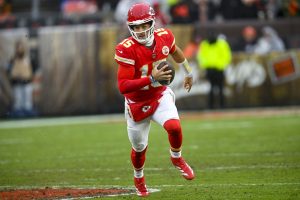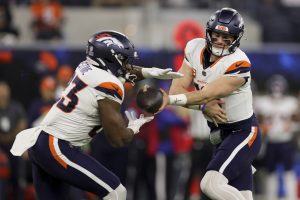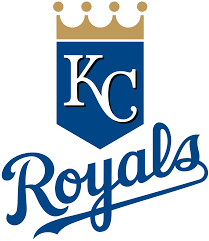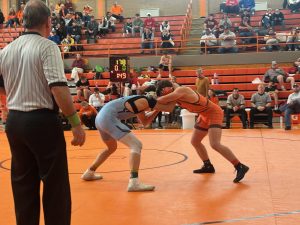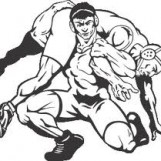Being an MLB catcher is grueling work. That’s not slowing this year’s best on offense
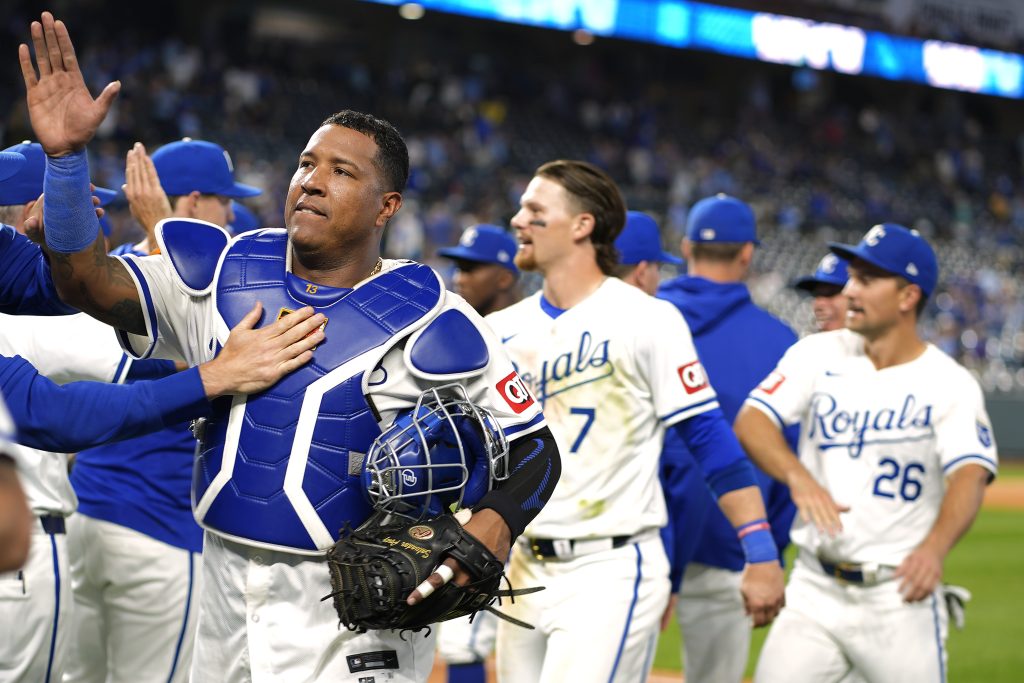
Kansas City Royals' Salvador Perez, left, celebrates with teammates after their baseball game against the Detroit Tigers Tuesday, May 21, 2024, in Kansas City, Mo. The Royals won 10-3. (AP Photo/Charlie Riedel)
By STEVE MEGARGEE AP Sports Writer
MILWAUKEE (AP) — Slowed by stiff knees and bruised by foul balls and backswings, major league catchers have long been defined by what they do defensively — even if it hinders them on offense. Perhaps because of the universal designated hitter and strategic changes like one-knee squatting, that might be changing.
Major league catchers have an average OPS of .691 through Wednesday, not far from the league-wide average of .697 for players at all positions. A season hasn’t ended with catchers having a higher average OPS than the league-wide mark since 1879. The closest it’s come to happening since 1900 was in 1977, when catchers were at .733 while the league average was .741.
“When you have a young group of catchers like we do in our game right now, talented catchers in our game right now, you’re going to see this,” said Cleveland Guardians manager Stephen Vogt, who caught in the majors from 2012-22. “The catching position is probably as good as it’s been in years, for sure.”
Leading the way are Kansas City’s Salvador Perez (.923), Milwaukee’s William Contreras (.903), the Los Angeles Dodgers’ Will Smith (.876), Baltimore’s Adley Rutschman (.815), Philadelphia’s J.T. Realmuto (.781) and Colorado’s Elias Díaz (.774). No catcher has ended a year with an OPS of .900 or higher with at least 502 plate appearances since San Francisco’s Buster Posey at .957 in 2012.
Given the demanding nature of the position, it’s reasonable to expect catchers’ hitting production to tumble in the second half. Pittsburgh Pirates manager Derek Shelton, a former minor league catcher and major league hitting coach, says he believes it will level off. New York Yankees catcher Jose Trevino said it’s hard to predict what might happen but acknowledged the toll the position takes.
“It’s going to wear you down just because of the workload, right?” Trevino said. “So, yeah, I think normally it’s going to have an effect on you for sure.”
Yet some catchers, such as the Contreras brothers, have bucked the trend.
Contreras caught a career-high 108 games for Milwaukee last year, yet his OPS improved from .773 in the first half to .873 in the second. Contreras is the younger brother of injured St. Louis Cardinals catcher Willson Contreras, a three-time All-Star whose OPS went from .754 in the first half to .959 in the second half last year. Willson Contreras is out at least six weeks after a swing by the Mets’ J.D. Martinez broke his left forearm.
One possible reason for the improvement: More and more backstops in recent seasons have eschewed the traditional catchers squat for a one-knee down stance in order to improve their pitch framing. Vogt thinks the change has also helped limit the stress on their legs.
“They’re going to be able to play more,” Vogt said. “They’re going to be able to play a lot longer. They’re not going to take the pounding and the wear and tear in their knees and hips and back like a lot of the traditional catchers did.”
Fox analyst A.J. Pierzynski, who caught in the majors from 1998-2016, downplayed the impact of the one-knee-down approach on catchers’ improved hitting. Pierzynski points out that catchers still face plenty of challenges physically and mentally.
“It does take some strain off of you, but you still get foul balls, you still get a lot of the same stuff,” Pierzynski said.
Pierzynski says a bigger factor is the way catchers are being used. The National League’s adoption of the designated hitter in 2022 makes it easier for catchers to stay in the lineup even when they aren’t behind the plate.
That means players aren’t having to catch as many games.
The only player to work behind the plate in at least 130 games either of the last two seasons is Realmuto, who caught 133 games each of those years. By contrast, at least four players caught 130-plus games every year from 2011-14.
Yet the best hitting catchers are actually in the lineup more often than before. William Contreras, whose .323 batting average ranks fifth in the NL, says his occasional DH assignments have helped him stay in a rhythm at the plate.
“When there was no DH in the National League, your days off were kind of your days off,” Contreras said through an interpreter. “Now we’re kind of able to treat my DH days as my days off and we’re able to keep my bat in the lineup for the team. It definitely helps.”
Rutschman has thrived as a DH, with a 1.033 OPS in 18 games there compared to a .691 OPS when he’s catching.
Pierzynski said players such as the Contreras brothers, Rutschman or Perez also can stay fresher at the plate during their non-catching days because they get a break from having to concentrate on how to handle a pitching staff or how to attack an opposing lineup on those days.
“Let’s say you’re Adley Rutschman,” Pierzynski said. “(You’re thinking), ‘How are we going to get Aaron Judge out today? Guess what, I don’t have to worry about it because I’m a DH. All I’ve got to do is worry about is how I’m going to get a hit and drive in some runs for these guys.'”
Teams with the best offensive catchers have capitalized on this opportunity.
Perez has missed just two games and Rutschman has sat out just three this season.
Perez and Rutschman have missed just two games each this season. Perez has 13 starts at first base and seven at DH. Rutschman has 32 starts and 34 overall appearances as a catcher.
William Contreras hasn’t missed a game since Aug. 20 of last season.
“It’s just something that mutually we’ve gotten to this point in the season playing pretty well, and I’m feeling really good,” said Contreras, who had made 45 starts at catcher and 10 at DH through Wednesday. “I don’t think I’m ready for that day off yet. That’s what I come to the stadium every day for, is to come and get my body ready to play and to be out there and play the game.
“At this point, we’re going to kind of keep doing it. Maybe down the line, there will be a day off in there.”
The hitting surge from catchers comes at an ideal time.
An automated ball-strike system is being used at the Triple-A level for a second straight season, raising the possibility that it eventually could reach the majors. It will become more essential for catchers to provide offense if pitch framing becomes less important.
The emergence of players such as Contreras and Rutschman has helped alter the league-wide perception of catchers, a shift that should continue to take hold even if they don’t maintain this history-making pace at the plate.
“The catching position has definitely changed,” Pierzynski said. “It’s definitely becoming a more offensive position. If you can find a catcher who can give you DH days and can throw a little bit, frame a pitch here and there but also be an offensive force, that’s value.”
___
AP baseball writer Ron Blum and AP sports writer Tom Withers contributed to this report.


